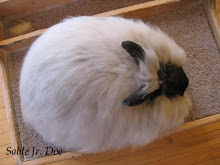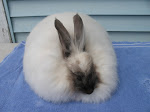Several winters ago my kids (and I) decided to embark on an experiment having to do with the rate of water freezing in specific types of containers. Since the kids were young at that time we did not conduct it as scientifically as we might have (next time I think we'll try to use identical sized containers and put metal thermometers into each one, etc.), but we did manage to clearly see results based on our observations by checking the containers every 15 min. to detect changes/freezing rates.
Since many breeders are in the midst of frigid temperatures right now it seems like a good time to review the results that we got so many years ago. Even though many people probably realize this already and have long since put it into practice, I will post it here again just for fun and review:).
We were interested to find out if the rate of water freezing was significantly affected by the material that the holding container was made out of---in other words---would water freeze faster in containers that were made out of metal, ceramic, or plastic?
To test our ideas (actually "hypotheses", since we are being technical---every kid had their own idea of what would freeze first:)), we set three containers out on the back porch. One container was plastic, the other was made of ceramic, and the third was made out of metal (all three were rabbit crocks). Just for fun I also set out a water bottle tilted upside down in the same position that it would be hanging in a rabbit cage.
Again, this was NOT an experiment that could be considered totally technical because the containers were not exactly the same size/depth/capacity, and all things were not 100% equal, but we did pour the same amount of room temperature water into each one (measured out), and we set them all out into 15 degree weather at the same time.
Predictably, the first container to freeze up instantly was the zip tube on the water bottle. It took a mere 15 minutes to freeze to the point where it was practically impossible to get any water out of it, yet the water in the bottle was still liquid and fully thawed .
The second dish to freeze up was the metal one, which lasted longer than the bottle but not as long as the ceramic or plastic dishes. A little while later the ceramic began to freeze, and the dish that wound up lasting nearly twice as long as everything else was the plastic crock (the lock croc/ twist crock type), and it was such an obvious winner that I decided to use plastic exclusively every winter in my rabbitry from that point on:).
Again, this test could have been performed to get more definite results (it could have been timed better with the temperature of the water measured precisely, etc.), but I have found in the barn just from plain old observation that plastic seems to stay liquid for at least 2 hours even in the coldest temperatures as long as it is filled up with warm water initially, and it is very easy to re-liquify during the day if I add a layer of very hot water to the top to thaw them out later on. Also, ceramic has the potential to crack and break if water freezes inside it, and metal can actually get 'sticky' with cold if drips of water freeze onto the outside where bunnies can brush up against it with their wool.
One type of container that we did NOT test but that many people rave about in the winter is the rubber dish. I don't know how long the water stays liquid in containers of this type, but the great thing about rubber is supposed to be that you can simply flip it over, stomp on it (or twist it), and the ice will pop right out. Rubber dishes are not often available in small sizes, but if you can find them it may be worth a trial in the rabbitry.
In summary (since we ARE being semi-scientific here:)), the results of this test indicate that it is NOT a good idea to use water bottles in the wintertime. If you have an automatic watering system there may be ways to stop zip tubes from freezing, but with standard, run of the mill Lixit bottles there is no sure way to keep them thawed long enough for a rabbit to get an ample supply of water. You are better off switching to crocks completely in winter, preferably plastic or (maybe) rubber. Around here we usually use the 20 oz. twist crocks because they are so easy to twist off and dump into a bucket to thaw, and they are easy to stack up and bring outside. The Loc Crocs are great also, but there is always the chance (usually when it is 20 below zero:)) of that little knob/washer falling out of your cold fingers onto the floor and rolling underneath the cages never to be seen in the world again, LOL. I prefer the crocks with no tiny parts:).
Anyway, more on Wednesday when I will post pictures of the bunnies who will be for sale at the PA Convention and a few other things. Have a great week!:-)
Monday, January 21, 2008
Subscribe to:
Post Comments (Atom)























No comments:
Post a Comment